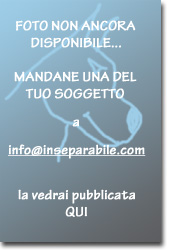PONT-AUDEMER SPANIEL
(Epagneul de Pont-Audemer)

We are collecting the material for being able to realize the card of the Epagneul de pont au de mer
FCI-Standard N° 114 / 25. 09.1998 / GB
TRANSLATION : Mrs. Peggy Davis.
ORIGIN : France.
DATE OF PUBLICATION OF THE ORIGINAL VALID STANDARD : 06.05.1964.
UTILIZATION : Pointing dog.
CLASSIFICATION F.C.I. :Group 7 Pointing Dogs.
Section 1.2 Continental Pointing Dogs, « Spaniel » type.
With working trial.
GENERAL APPEARANCE : Stocky and vigorous dog.
HEAD
SUGGESTED BREEDINGS by MENANDPETS.COM:
No breeding to signal
if you want to know like signaling yours, contacts: marketing@inseparabile.it
CRANIAL REGION :
Skull : Round and developed at the top, occipital crest prominent; the parietals are rather round. The forehead rising towards the topknot which must be very curly and well placed on the top of the skull, leaving the forehead bare.
Stop : Forming a weak angle, although marked.
FACIAL REGION :
Nose : Brown, protruding perceptibly above the front of the lips, rather pointed.
Muzzle : Long, arched in the middle part.
Lips : Fine and slightly let down, making the muzzle rather pointed.
Eyes : Dark amber or hazel, rather small, well set into the socket; kind and frank expression.
Ears : Medium thickness, flat, set on rather low in such a way as to keep them away from the cheeks; long and furnished with long silky very curly hair, joining the top knot to show a beautiful curly wig really framing the head.
NECK : A little arched, neat, well muscled, joining finely to the head and solidly to the shoulders.
BODY :
Back : Straight or slightly convex.
Loin : Quite short, broad, solid, muscular.
Croup : Very slightly oblique.
Chest : Deep, broad, going down fully to level of the elbow; ribs ong and protruding, the last rib close to the hip.
Flanks : Flat and a little raised.
TAIL : Set almost at the level of the loin line, carried quite straight, generally docked to one third of its length; thick at the base, well feathered with curly hair which should surround the tail completely. When the tail is not docked, it must be of medium length, carried a little curved.
LIMBS : The legs must be rather short, the dog being rather low to the ground, yet without falling into the Cocker type.
FOREQUARTERS :
Shoulders : Strong, long, sloping, close at the point where they join the spinal column.
Upper arm : Strong and muscled.
HINDQUARTERS :
Haunch : Prominent and reaching the height of the back.
Thighs : Straight, well let down, muscular, fleshy, with culottes. Point of buttock prominent.
Hock joint : Broad and straight, without deviation either in or out.
Hocks : Rather short, furnished especially at the back with a curly fringe. Dewclaws to be avoided.
FEET : Round, set true, furnished with long, curly hairs between the toes.
COAT
HAIR : Curly and slightly ruffled.
COLOUR : Brown, preferably brown and grey mottled, with dead leaf glints.
SIZE :
52 - 58 cm.
FAULTS : Any departure from the foregoing points should be considered a fault and the seriousness with which the fault should be regarded should be in exact proportion to its degree.
- Skull flat on the sides, forehead parallel to the muzzle; lack of topknot, topknot reaching to the superciliary arches or topknot formed by hanging hair.
- Stop forming a weak angle, although marked.
- Nose black, pale, dudley nose or round.
- Muzzle short or too convex.
- Lips thick, with flews.
- Eyes too light, set level with the head surface or too sunken. Look unfriendly or vicious.
- Ears thick, folded, too short, set too high, carried either forward or backward.
- Neck too heavy, flat on its top line, too thick in its junction with the head.
- Back long, narrow or hollow.
- Loin long, narrow or flat.
- Croup falling steeply away, too straight.
- Chest insufficiently let down, too round or hollow; ribs flat or too close together.
- Flanks too fleshy, too deep.
- Tail set too high or too low, too curved, carried sabre fashion with a plume.
- Shoulders short, straight, wide apart at the summit.
- Upper arm thin.
- Haunch low set.
- Thigh flat.
- Hock joints deviated, straight, too wide apart or too close together.
- Hocks long, oblique from back to front or deviating to the right or the left, without fringes.
- Feet narrow, much too broad, too hairy; fleshy pads.
- Coat too flat, too curly, too hard or too fine; topknot not curly or falling as in the Poodle.
- Colour black or black and white, presence of tan markings.
Any dog clearly showing physical or behavioural abnormalities shall be disqualified.
N.B. : Male animals should have two apparently normal testicles fully descended into the scrotum.
© menandpets All rights reserved.
|
